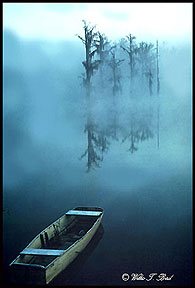
© Willis T. Bird. All rights reserved.
After all my years of observing photographs, I still ask, “Good, in whose opinion?” No matter what you may hear, the subject matter does make a difference. If I love sunsets and I have to pick between equally good photos of a bird and a sunset, I’ll most likely choose the sunset. So, if you’re making photos strictly for yourself, you’ll do better photographing what you enjoy.
Next, I ask myself, “What do I mean by equally good?” I mean technically equal in composition, impact, color, and sharpness. The more you observe the work of others, the better you’ll be able to critique your own products. In other words, the longer you’ve been creating image, the better photographer you should become. An example: Some of the photos I entered in contests when I began many years ago are the same type that a few years later I would have thrown in the trash without considering them as entries.
Critiques of Your Work
Attending camera clubs can help, because you’re able to examine the work of many other photographers. Usually, there are some photographers in the group whom you judge to be better than you are and some to whom you judge yourself to be superior. And you’re correct.
Check to see if the club you’re considering has a critique night when anyone can enter photos, slides, or digital images. And in return, see if any member can offer comments. Not all comments will be correct or pertinent, but you learn to weed out those that don’t fit from those that teach you something important.
Another fun activity a club can enjoy is a night when we select a subject for a competition to be held a couple months later. Example: At the first of the year, the member’s at the club I attend hand in one-word (or more) suggestions for subjects. The suggestions are each given a number, so that members don’t know what number goes with what suggestion. We then select someone to call out a number, and the suggestion that correlates to the number becomes the subject of the next competition. Because the subjects are briefly stated, they give great leeway to the individual photographer’s creativity. It’s always fun to see how each photographer interprets the subject, which keeps the competition lighthearted and fun while forcing the members to think and explore, as well. (Many clubs lack similarly creative stimulation, so if the one you choose doesn’t do this, you could certainly make the suggestion.)
As a serious photographer, you can’t wear your feelings on your sleeves. Some folks will love your photos, and some will not. If your work is critiqued and you don’t understand the criticism, you have every right to question the person giving the comments further to find out what he or she means. If you disagree, you can tell him or her why. Both of you can, and often do, learn in such a situation. But don’t make an argument out of the conversation. Remember, the idea is to learn–not to win or lose a fight.
If you don’t like coping with one-on-one criticism, face-to-face, take a look at the online photo forums. There you can post your photos and read the reactions they inspire in the comfort and quiet of your computer room. Keep in mind, if you don’t want honest dialogue, don’t ask for it. But if you want to learn, try some type of critique session. I’ve submitted many a photo that I thought was pretty good for critique, only to discover how I could have made my image even better.
Creating Images with Impact

© Willis T. Bird. All rights reserved.
When you’re determining what makes a good photo, you must consider the context in which it was taken. The guidelines for a studio image will be different from a photojournalism image, which is often made in a split-second. While you expect the sharpness, colors, and composition of the studio photo to be perfect, you can’t ask the same of a photo of a racecar tumbling out of control at high noon on a super speedway. But the impact of the racecar image may make it a winner, in spite of a lack of other controls. To me, impact is the single deciding factor that makes an unexpected photo a champion (one where you can’t wait for that perfect light). That one feature can overcome other flaws. Of course, if you have sharpness, colors, composition, and impact all in one image, you have the perfectly created photo. So, strive for the very best technical photo you can produce under the conditions in which you’re working.
Exactly what do I mean by impact? Let’s say you have a landscape photography of a snow-covered mountain. It’s perfect in every way. Composition, lighting, colors, and sharpness are right-on. But then, right next to you, is a photo of the same scene, done just as well, but it has a rainbow arching over the mountain or a bald eagle soaring in the foreground…that’s impact! That image is more likely to take the ribbon. Okay, so that photographer was lucky. Luck counts, but you need to be ready when luck comes your way!

© Willis T. Bird. All rights reserved.
Sometimes, you have to make your own luck. One day I was taking photos of cloud formations, and a beautiful rainbow appeared. It fell upon drab fields and wasn’t particularly interesting, but I drove around until I found a place where the rainbow seemed to fall upon a farm and illuminate it. There’s the impact I needed. At times, the photo comes to you, but now and then, you have to go and really look for the photo. Don’t always be satisfied with the first impression that comes to you. Be creative. Look for the impact feature!
by Willis T. Bird

Leave a Reply